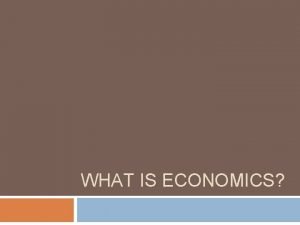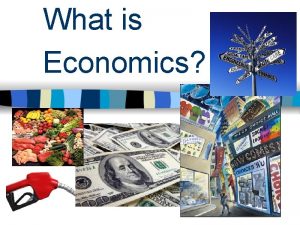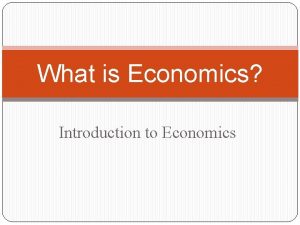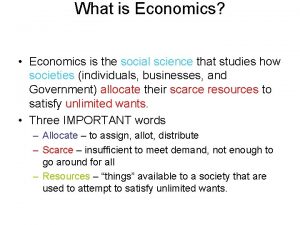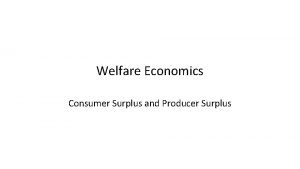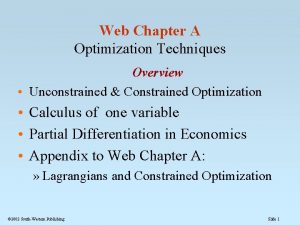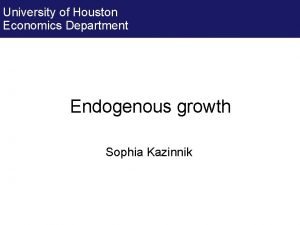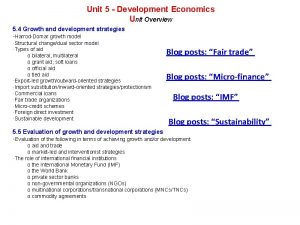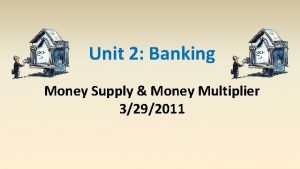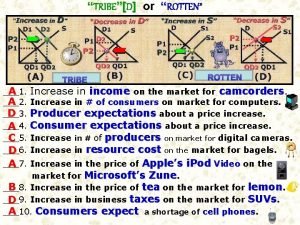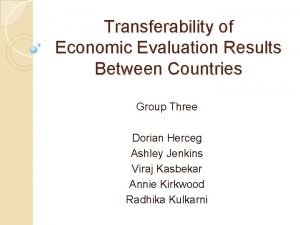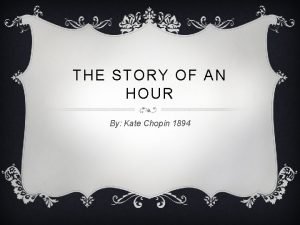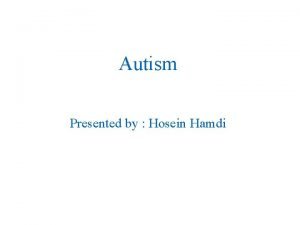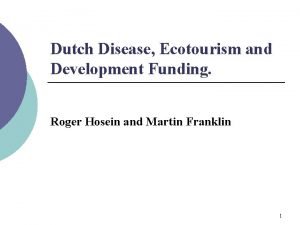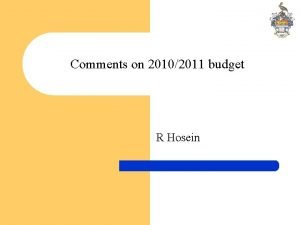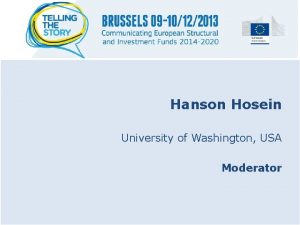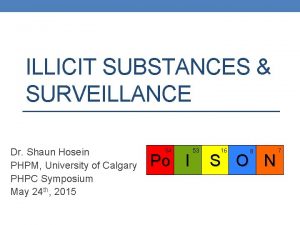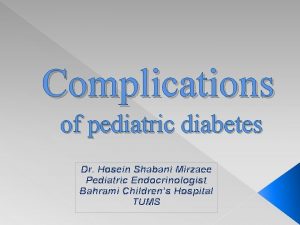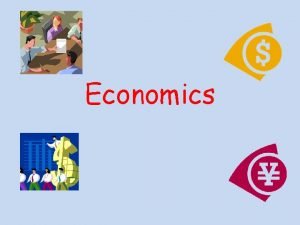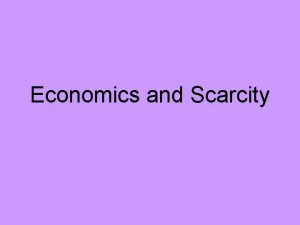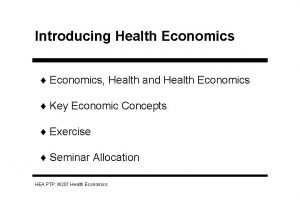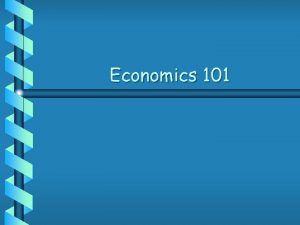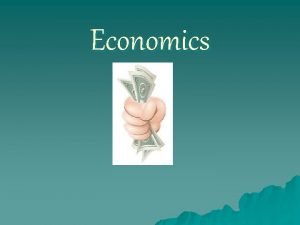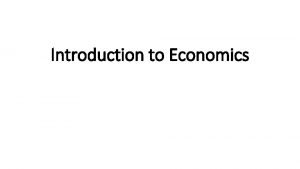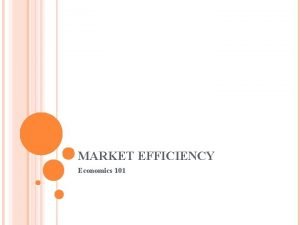Hosein Joshaghani Education Ph D in economics at




























- Slides: 28

Hosein Joshaghani Education Ph. D in economics at the University of Chicago Research Interests Empirical Macroeconomics, Labor Economics, Behavioral Economics Key Professional Activities Visiting Assistant Professor at Graduate School of Management and Economics, Sharif University of Technology 1

Responses of Job and Worker Flows to Oil and Exchange Rate Shocks Hosein Joshaghani Kiarash Hoseiny 2

Introduction • What can we learn from sectoral job and worker flows? • How large is the job reallocation in Iran relative to developed countries? • How do oil (and real exchange rate) shocks affect job creation and job destruction (as well as hire and separation rates) across sectors? • Are they reallocative or aggregate shocks? Sharif University of Technology H. Joshaghani, K. Hoseiny 3

Job Flows versus Worker Flows Sharif University of Technology H. Joshaghani, K. Hoseiny 4

Job Flows versus Worker Flows Job Flows Worker Flows Job Creation and Destruction Hire and Separation Demand Side Supply Side Survey of Manufacturing Plants Labor Force Survey 1382 - 1392 1385 -1393 Yearly Quarterly Only manufacturing Covers all sectors Only plants with more than 10 workers Covers all plant sizes Some years, some regions survey of plants with 10 -50 workers But universe of plants with more than 50 employees Sharif University of Technology H. Joshaghani, K. Hoseiny Always a survey 5

Job Flows: Creation and Destruction Sharif University of Technology H. Joshaghani, K. Hoseiny 6

Sharif University of Technology H. Joshaghani, K. Hoseiny 7

Job Flow Rates Sharif University of Technology H. Joshaghani, K. Hoseiny 8

Sharif University of Technology H. Joshaghani, K. Hoseiny 9

St. Dev. Mean job St. Dev. Of Employment Of Of creation destruction share creation growth rate rate Industry (ISIC 2 -digit) food products and beverages - tobacco products 15. 6 8. 0 14. 6 11. 2 10. 4 11. 6 4. 5 4. 8 1. 2 2. 4 5. 1 5. 9 1. 6 15. 1 11. 8 5. 6 3. 9 6. 0 publishing, printing and reproduction of recorded media - paper and paper products 2. 4 12. 4 8. 9 6. 8 2. 3 7. 5 coke, refined petroleum products and nuclear fuel 2. 0 8. 7 4. 1 11. 6 9. 3 15. 0 14. 6 13. 1 14. 2 7. 7 6. 5 8. 4 9. 8 6. 7 11. 2 5. 5 5. 8 5. 2 4. 9 5. 7 1. 8 2. 4 2. 1 1. 7 15. 2 5. 1 7. 1 6. 5 5. 3 13. 0 12. 7 10. 2 6. 1 1. 7 6. 8 office, accounting and computing machinery - electrical machinery and apparatus n. e. c. - radio, television and communication equipment and apparatus 5. 9 12. 7 9. 7 6. 9 1. 4 7. 2 medical, precision and optical instruments, watches and clocks 1. 1 13. 0 8. 1 6. 8 5. 0 9. 7 motor vehicles, trailers and semi-trailers - other transport equipment furniture; manufacturing n. e. c. - recycling 14. 3 1. 2 10. 7 13. 6 7. 3 9. 8 5. 5 5. 8 2. 3 7. 1 6. 5 textile wearing apparel; dressing and dyeing of fur - tanning and dressing of leather; manufacture of luggage, handbags, saddlery, harness and footwear - wood and products of wood and cork, except furniture; chemicals and chemical products rubber and plastics products other non-metallic mineral products basic metals fabricated metal products, except machinery and equipment - machinery and equipment n. e. c. Sharif University of Technology H. Joshaghani, K. Hoseiny 10

Food Products: 8. 0% Employment Share Sharif University of Technology H. Joshaghani, K. Hoseiny 11

Textile: 15. 6% Employment Share Sharif University of Technology H. Joshaghani, K. Hoseiny 12

Job Creation and Destruction and Plant size Mean job St. Dev. Of Establishme Employment Mean job St. Dev. Of destruction nt size share creation rate growth rate 50 -100 24. 6 16. 0 6. 1 4. 6 5. 3 100 -250 22. 8 14. 1 11. 7 6. 3 3. 7 6. 2 250 -500 18. 0 12. 8 10. 4 5. 6 3. 1 5. 9 500 -2000 22. 6 10. 9 7. 9 4. 1 2. 4 4. 6 11. 9 7. 7 3. 4 5. 0 2. 1 5. 9 2000+ Sharif University of Technology H. Joshaghani, K. Hoseiny 13

Labor Intensity and Job Flows Sharif University of Technology H. Joshaghani, K. Hoseiny 14

Job Creation and Destruction and Labor Intensity Labor intensity quartile Mean job St. Dev. Of Employment Mean job St. Dev. Of destruction share creation rate growth rate 1 25. 0 11. 9 6. 9 3. 9 2. 1 4. 9 2 25. 0 13. 0 7. 4 4. 2 1. 0 3. 8 3 25. 0 13. 1 8. 7 6. 4 1. 0 6. 6 4 25. 0 14. 7 10. 9 5. 0 1. 9 5. 7 Sharif University of Technology H. Joshaghani, K. Hoseiny 15

Sharif University of Technology H. Joshaghani, K. Hoseiny 16

Job Flows: Summary We find surprisingly large rates of job creation, destruction and reallocation: • Job creation and destruction in Iran: 11 -15 percent • Job creation and destruction in the U. S. : 14 -18 percent This is persistent across industries and over time. Job creation (and destruction) is more concentrated on: • Smaller plants • Younger plants • More labor intensive plants Sharif University of Technology H. Joshaghani, K. Hoseiny 17

Responses to Oil and Real Exchange Shock Sharif University of Technology H. Joshaghani, K. Hoseiny 18

Cholesky Identification Sharif University of Technology H. Joshaghani, K. Hoseiny 19

Oil and Real Exchange Rate Shocks Sharif University of Technology H. Joshaghani, K. Hoseiny 20

Responses of Job Creation and Destruction To Oil Shocks Sharif University of Technology H. Joshaghani, K. Hoseiny 21

Summary of OIL shocks • Positive oil shocks increase job creation but decrease job destruction aggregate effects dominate reallocation effects • Oil shocks are not symmetric: positive and negative shocks are different Sharif University of Technology H. Joshaghani, K. Hoseiny 22

Oil Shocks versus Real Exchange Rate Shocks Sharif University of Technology H. Joshaghani, K. Hoseiny 23

Responses of Job Flows To Oil and RER Shocks Sharif University of Technology H. Joshaghani, K. Hoseiny 24

Are the responses the same across sectors? No! Textile 8% Employment Share Sharif University of Technology H. Joshaghani, K. Hoseiny 25

Are the responses similar across sectors? No! Printing & Paper 2. 4% Employment Share Sharif University of Technology H. Joshaghani, K. Hoseiny 26

Conclusion • There are lot of information in sectoral labor market outcomes. • To understand aggregate phenomena, such as jobless recoveries, low FLFP, etc. , one needs sectoral analysis. • Oil and real exchange rate shocks both affect the economy through aggregate channels. • Though some sectors reallocation effect of the shocks dominate. Sharif University of Technology H. Joshaghani, K. Hoseiny 27

 Hosein joshaghani
Hosein joshaghani Hosein amooshahi
Hosein amooshahi School of business and economics maastricht
School of business and economics maastricht Mathematical vs non mathematical economics
Mathematical vs non mathematical economics Family economics and financial education
Family economics and financial education Family economics and financial education
Family economics and financial education Aims of teaching economics
Aims of teaching economics Family economics and financial education
Family economics and financial education Is als a non formal education
Is als a non formal education Different between health education and health promotion
Different between health education and health promotion Backbone of extension education
Backbone of extension education What is economics
What is economics What economics is
What economics is Scarcity definition economics
Scarcity definition economics Needs and wants examples
Needs and wants examples What is economics in social science
What is economics in social science Producer
Producer Producer surplus example
Producer surplus example Art with economics
Art with economics Constrained and unconstrained optimization in economics
Constrained and unconstrained optimization in economics Euler equation economics
Euler equation economics National development
National development Deposit multiplier
Deposit multiplier Unemployment
Unemployment Impossible trinity economics
Impossible trinity economics Trade off definition economics
Trade off definition economics Tribe and rotten economics
Tribe and rotten economics Transferable economics definition
Transferable economics definition 1950s home economics textbook
1950s home economics textbook











